Sony CDX-GT61UI User Manual
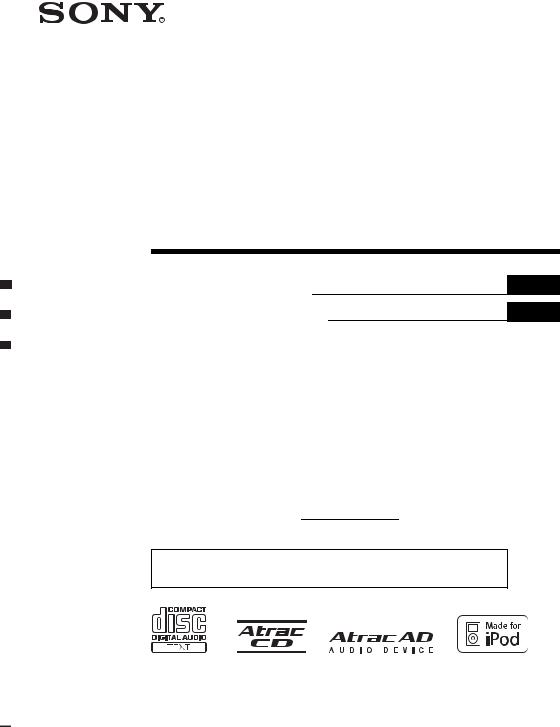
3-096-839-11 (1)
FM/AM
Compact Disc Player
Operating Instructions Manual de instrucciones
Owner’s Record
US
ES
The model and serial numbers are located on the bottom of the unit. Record the serial number in the space provided below.
Refer to these numbers whenever you call upon your Sony dealer regarding this product.
Model No. CDX-GT61UI Serial No.
To cancel the demonstration (DEMO) display, see page 12.
Para cancelar la pantalla de demostración (DEMO), consulte la página 13.
CDX-GT61UI
© 2007 Sony Corporation
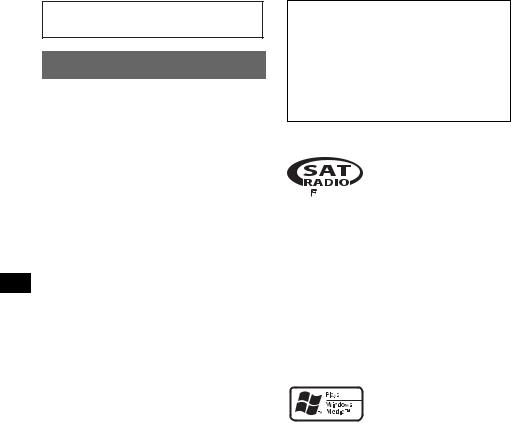
For installation and connections, see the supplied installation/connections manual.
Warning
This equipment has been tested and found to comply with the limits for a Class B digital device, pursuant to Part 15 of the FCC Rules. These limits are designed to provide reasonable protection against harmful interference in a residential installation. This equipment generates, uses, and can radiate radio frequency energy and, if not installed and used in accordance with the instructions, may cause harmful interference to radio communications. However, there is no guarantee that interference will not occur in a particular installation. If this equipment does cause harmful interference to radio or television reception, which can be determined by turning the equipment off and on, the user is encouraged to try to correct the interference by one or more of the following measures:
–Reorient or relocate the receiving antenna.
–Increase the separation between the equipment and receiver.
–Connect the equipment into an outlet on a circuit different from that to which the receiver is connected.
–Consult the dealer or an experienced radio/TV technician for help.
You are cautioned that any changes or modifications not expressly approved in this manual could void your authority to operate this equipment.
CAUTION
The use of optical instruments with this product will increase eye hazard.
For the state of california, USA only
Perchlorate Material – special handling may apply, See www.dtsc.ca.gov/hazardouswaste/perchlorate Perchlorate Material: Lithium battery contains perchlorate
Warning if your car’s ignition has no ACC position
Be sure to set the Auto Off function (page 12). The unit will shut off completely and automatically in the set time after the unit is turned off, which prevents battery drain.
If you do not set the Auto Off function, press and hold (OFF) until the display disappears each time you turn the ignition off.
The “SAT Radio Ready” logo indicates that this
product will control a satellite




 radio tuner module (sold separately). Please see your nearest authorized Sony dealer for details on the satellite radio tuner module.
radio tuner module (sold separately). Please see your nearest authorized Sony dealer for details on the satellite radio tuner module.
“SAT Radio,” “SAT Radio Ready,” the SAT Radio and SAT Radio Ready logos and all related marks are trademarks of Sirius Satellite Radio Inc. and XM Satellite Radio Inc.
“ATRAC”, “ATRAC AD”, SonicStage and their logos are trademarks of Sony Corporation.
“WALKMAN” and “WALKMAN” logo are registered trademarks of Sony Corporation.
Microsoft, Windows Media, and the Windows logo are
trademarks or registered trademarks of Microsoft
Corporation in the United States and/or other countries.
iPod is a trademark of Apple Computer, Inc., registered in the U.S. and other countries.
2

Table of Contents
Welcome ! . . . . . . . . . . . . . . . . . . . . . . . . . . . . . 4
Getting Started
Resetting the unit. . . . . . . . . . . . . . . . . . . . . . . . 4 Preparing the card remote commander . . . . . . . 4 Setting the clock . . . . . . . . . . . . . . . . . . . . . . . . 5 Detaching the front panel . . . . . . . . . . . . . . . . . 5 Attaching the front panel . . . . . . . . . . . . . . . 5
Location of controls and basic operations
Main unit. . . . . . . . . . . . . . . . . . . . . . . . . . . . 6 Card remote commander RM-X151 . . . . . . . 6
CD
Display items . . . . . . . . . . . . . . . . . . . . . . . . 8 Repeat and shuffle play. . . . . . . . . . . . . . . . . 8
Radio
Storing and receiving stations . . . . . . . . . . . . . . 8 Storing automatically — BTM . . . . . . . . . . . 8 Storing manually. . . . . . . . . . . . . . . . . . . . . . 8 Receiving the stored stations . . . . . . . . . . . . 8 Tuning automatically . . . . . . . . . . . . . . . . . . 9
USB devices
Playing back USB devices . . . . . . . . . . . . . . 9 Display items . . . . . . . . . . . . . . . . . . . . . . . . 9 Listening to music on a Mass Storage Class type audio device . . . . . . . . . . . . . . . . . . . . 10 Listening to music on “Walkman” (ATRAC Audio Device). . . . . . . . . . . . . . . . . . . . . . . 10
iPod
Playing back iPod . . . . . . . . . . . . . . . . . . . . . . 10 Playing tracks . . . . . . . . . . . . . . . . . . . . . . . 10 Display items . . . . . . . . . . . . . . . . . . . . . . . 11 Setting the play mode . . . . . . . . . . . . . . . . . . . 11 Selecting Album, Artist or Playlist . . . . . . . 11 Repeat and shuffle Play . . . . . . . . . . . . . . . 11 Scan. . . . . . . . . . . . . . . . . . . . . . . . . . . . . . . 11
Other functions
Changing the sound settings . . . . . . . . . . . . . . 12 Adjusting the sound characteristics
— BAL/FAD/SUB. . . . . . . . . . . . . . . . . . . 12 Customizing the equalizer curve
— EQ3 . . . . . . . . . . . . . . . . . . . . . . . . . . . . 12 Adjusting setup items — SET . . . . . . . . . . . . 12 Using optional equipment. . . . . . . . . . . . . . . . 13 Auxiliary audio equipment. . . . . . . . . . . . . 13 CD/MD changer . . . . . . . . . . . . . . . . . . . . . 13
Additional Information
Precautions . . . . . . . . . . . . . . . . . . . . . . . . . . . 14 Notes on discs . . . . . . . . . . . . . . . . . . . . . . 14 About USB devices . . . . . . . . . . . . . . . . . . 15 Playback order of MP3/WMA/AAC
files . . . . . . . . . . . . . . . . . . . . . . . . . . . . . . . 15 About MP3 files . . . . . . . . . . . . . . . . . . . . . 16 About WMA files. . . . . . . . . . . . . . . . . . . . 16 About AAC files . . . . . . . . . . . . . . . . . . . . 16 About ATRAC files . . . . . . . . . . . . . . . . . . 16 About iPod . . . . . . . . . . . . . . . . . . . . . . . . . 16
Maintenance . . . . . . . . . . . . . . . . . . . . . . . . . . 16 Removing the unit. . . . . . . . . . . . . . . . . . . . . . 17 Specifications . . . . . . . . . . . . . . . . . . . . . . . . . 18 Troubleshooting . . . . . . . . . . . . . . . . . . . . . . . 18 Error displays/Messages. . . . . . . . . . . . . . . 20
3
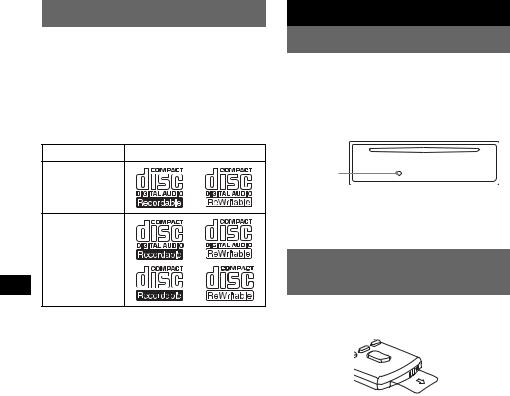
Welcome !
Thank you for purchasing this Sony Compact Disc Player. You can enjoy your drive with the following functions.
•CD playback
You can play CD-DA (also containing CD TEXT*1), CD-R/CD-RW (MP3/WMA/AAC files also containing Multi Session (page 15)) and ATRAC CD (ATRAC3 and ATRAC3plus format (page 16)).
Type of discs |
Label on the disc |
CD-DA
MP3
WMA
AAC
ATRAC CD
•Radio reception
–You can store up to 6 stations per band (FM1, FM2, FM3, AM1 and AM2).
–BTM (Best Tuning Memory): the unit selects strong signal stations and stores them.
•Sound adjustment
–EQ3 stage2: You can choose any one of 7 preset equalizer curves.
•Optional unit operation
Various kinds of audio devices can be connected, and operated from the unit.
–iPod: iPod connection can be made by the dock connector cable on the rear of the unit.
–USB device: A Mass Storage Class USB device, or “Walkman” (AAD*2) can be connected to the front USB terminal. For details on a usable devices, please refer to About USB devices (page 15) or the Sony support website (page 21).
–Portable audio device: An AUX input jack on the front of the unit allows connection of a portable audio device (analog connection).
–CD/MD changers: CD/MD changers can be connected to the SONY BUS at the rear of the unit.
*1 A CD TEXT disc is a CD-DA that includes information such as disc, artist and track name.
*2 ATRAC Audio Device
Getting Started
Resetting the unit
Before operating the unit for the first time, or after replacing the car battery or changing the connections, you must reset the unit.
Detach the front panel and press the RESET button with a pointed object, such as a ball-point pen.
RESET button
Note
Pressing the RESET button will erase the clock setting and some stored contents.
Preparing the card remote commander
Before using the card remote commander for the first time, remove the insulation film.
4
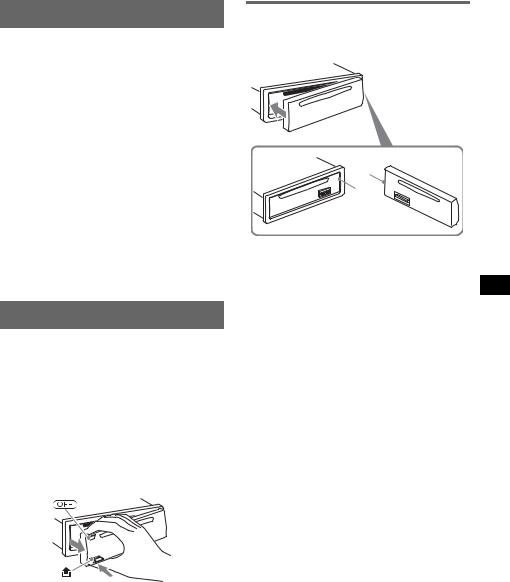
Setting the clock
The clock uses a 12-hour digital indication.
1Press and hold the select button.
The setup display appears.
2Press the select button repeatedly until “CLOCK-ADJ” appears.
3Press (SEEK) +.
The hour indication flashes.
4Rotate the volume control dial to set the hour and minute.
To move the digital indication, press (SEEK) –/+.
5Press the select button.
The setup is complete and the clock starts.
To display the clock, press (DSPL). Press (DSPL) again to return to the previous display.
With the card remote commander
In step 4, to set the hour and minute, press M or m.
Detaching the front panel
You can detach the front panel of this unit to prevent theft.
Caution alarm
If you turn the ignition switch to the OFF position without detaching the front panel, the caution alarm will sound for a few seconds. The alarm will only sound if the built-in amplifier is used.
1Press (OFF).
The unit is turned off.
2Press  , then pull it off towards you.
, then pull it off towards you.
Notes
•Do not drop or put excessive pressure on the front panel and display window.
•Do not subject the front panel to heat/high temperature or moisture. Avoid leaving it in a parked car or on a dashboard/rear tray.
•If the front panel is detached without turning off the switch during playback by a USB device, data may be damaged.
Attaching the front panel
Engage part A of the front panel with part B of the unit, as illustrated, and push the left side into position until it clicks.
A
B
Note
Do not put anything on the inner surface of the front panel.
5
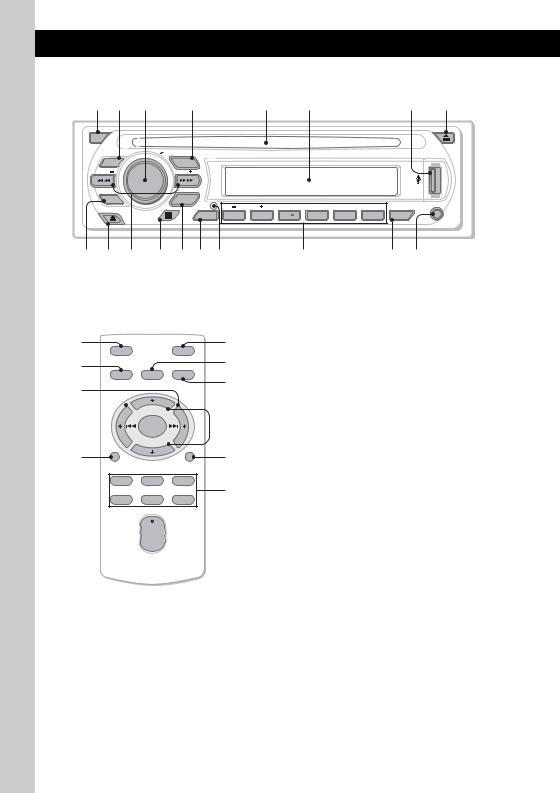
Location of controls and basic operations
Main unit
12 3 |
4 |
5 |
6 |
7 8 |
OFF |
|
|
|
|
|
PUSH SELECT |
|
|
|
EQ3 |
SOURCE |
|
|
|
SEEK |
SEEK |
|
|
|
CAT |
|
|
|
|
|
|
|
|
|
BTM |
MODE |
|
|
|
|
|
|
|
|
|
DIM |
|
GP/ALBM |
REP |
SHUF |
|
PAUSE |
|
|
|
DSPL |
1 |
2 |
3 |
4 |
5 |
6 |
SCRL |
AUX |
|
|
|
|
|
|
CDX-GT61UI |
9 q; qa qs qdqfqg |
qh |
qj qk |
||||
Card remote commander |
Refer to the pages listed for details. The |
|||||
RM-X151 |
|
|
|
corresponding buttons on the card remote |
||
|
|
|
commander control the same functions as those |
|||
|
|
|
|
|
||
1 |
|
|
|
wa |
on the unit. |
|
|
|
|
A OFF button |
|
||
OFF |
ATT |
|
||||
4 |
|
|
|
ws |
To power off; stop the source. |
|
|
MODE |
|
|
|||
SOURCE SEL |
B EQ3 (equalizer) button 12 |
|||||
ql |
|
|
|
qd |
||
|
|
|
|
To select an equalizer type (XPLOD, |
||
|
|
|
|
|
||
|
+ |
|
|
|
VOCAL, EDGE, CRUISE, SPACE, |
|
|
|
|
|
wd |
GRAVITY, CUSTOM or OFF). |
|
|
|
|
|
|
|
|
–C Volume control dial/select button 12
qf |
DSPL |
|
SCRL |
qj |
To adjust volume (rotate); select setup items |
|
(press and rotate). |
||||
|
|
|
|
|
|
|
1 |
2 |
3 |
wf |
D SOURCE button |
|
|
||||
|
4 |
5 |
6 |
To power on; change the source (Radio/CD/ |
|
|
|
||||
|
|
|
|
|
MD*1/USB/AUX/PD/SAT*2). |
+
w; VOL
VOL
–
EDisc slot
Insert the disc (label side up), playback starts.
F Display window
GUSB terminal 9
To connect to the USB device.
HZ (eject) button
To eject the disc.
IBTM/CAT*2 button 8
To start the BTM function (press and hold).
J  (front panel release) button 5
(front panel release) button 5
6

KSEEK –/+ buttons
CD/MD*1/USB*3/PD*4:
To skip tracks (press); skip tracks continuously (press, then press again within about 1 second and hold); reverse/fastforward a track (press and hold).
Radio:
To tune in stations automatically (press); find a station manually (press and hold).
LReceptor for the card remote commander
MMODE button 8, 10, 13
To select the radio band (FM/AM); select the SAT tuner band (mode)*2; select the unit*5; select the play mode*4*6.
NDSPL (display)/DIM (dimmer) button
8, 9, 11
To change display items (press); change the display brightness (press and hold).
ORESET button (located behind the front panel) 4
PNumber buttons
CD/MD*1/USB*3/PD*4:
(1)/(2): GP*7/ALBM*8 –/+
To skip groups/albums (press); skip groups/albums continuously (press and hold)*9.
(3): REP 8, 10, 11, 14
(4): SHUF 8, 10, 11, 14
(5): 11
(6): PAUSE*10
To pause playback. To cancel, press again.
Radio:
To receive stored stations (press); store stations (press and hold).
QSCRL (scroll) button 8, 9, 11
To scroll the display item.
RAUX input jack 13
To connect a portable audio device.
The following buttons on the card remote commander have also different buttons/functions from the unit. Remove the insulation film before use (page 4).
ql < (.)/, (>) buttons
To control CD/radio/MD/USB/PD, the same as (SEEK) –/+ on the unit.
w; VOL (volume) +/– button
To adjust volume.
wa ATT (attenuate) button
To attenuate the sound. To cancel, press again.
ws SEL (select) button
The same as the select button on the unit.
wd M (+)/m (–) buttons
To control CD, the same as (1)/(2) (GP/ ALBM –/+) on the unit.
wf Number buttons
To receive stored stations (press); store stations (press and hold).
*1 When an MD changer is connected.
*2 When the SAT tuner is connected.
*3 When a USB device is connected.
*4 When an iPod is connected.
*5 When a CD/MD changer is connected.
*6 When an ATRAC Audio Device is connected.
*7 When an ATRAC CD is played.
*8 When an MP3/WMA/AAC is played.
*9 If the changer/iPod is connected, the operation is different, see page 11, 13.
*10When playing back on this unit.
Notes
•When ejecting/inserting a disc, keep any USB devices disconnected to avoid damage to the disc.
•If the unit is turned off and the display disappears, it cannot be operated with the card remote commander unless (SOURCE) on the unit is pressed, or a disc is inserted to activate the unit first.
Tip
For details on how to replace the battery, see “Replacing the lithium battery of the card remote commander” on page 16.
About USB cap
When not using the USB terminal (G), use the supplied USB cap to prevent dust or dirt entering. Keep the USB cap out of the reach of children to prevent accidental swallowing.
7
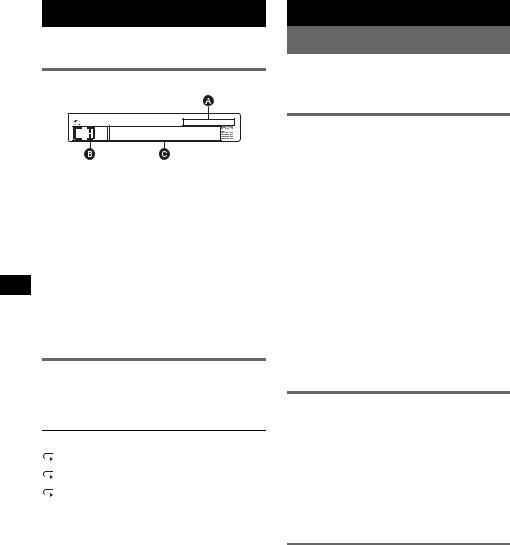
CD
For details on selecting a CD/MD changer, see page 13.
Display items
A AAC/WMA/ATRAC/MP3 indication B Source
CTrack/album/group number*, Disc/artist/ album/group/track name, Elapsed playing time, Text information, Clock
*Album/group number is displayed only when the album is changed.
To change display items C, press (DSPL); scroll display items C, press (SCRL) or set “A.SCRL-ON” (page 12).
Tip
Displayed items will differ, depending on the disc type, recorded format and settings. For details on MP3/ WMA/AAC, see page 16; ATRAC CD, see page 16.
Repeat and shuffle play
1During playback, press (3) (REP) or
(4) (SHUF) repeatedly until the desired setting appears.
Select |
To play |
TRACK |
track repeatedly. |
|
|
ALBUM*1 |
album repeatedly. |
GROUP*2 |
group repeatedly. |
SHUF ALBUM*1 |
album in random order. |
SHUF GROUP*2 |
group in random order. |
SHUF DISC |
disc in random order. |
|
|
*1 When an MP3/WMA/AAC is played.
*2 When an ATRAC CD is played.
To return to normal play mode, select “ OFF” or “SHUF OFF.”
OFF” or “SHUF OFF.”
Radio
Storing and receiving stations
Caution
When tuning in stations while driving, use Best Tuning Memory (BTM) to prevent an accident.
Storing automatically — BTM
1Press (SOURCE) repeatedly until
“TUNER” appears.
To change the band, press (MODE) repeatedly. You can select from FM1, FM2, FM3, AM1 or AM2.
2Press and hold (BTM) until “BTM” flashes.
The unit stores stations in order of frequency on the number buttons.
A beep sounds when the setting is stored.
Storing by the setup menu
1After step 1 above, press and hold the select button.
The setup display appears.
2Press the select button repeatedly until “BTM” appears.
3Press (SEEK) +.
Storing manually
1While receiving the station that you want to store, press and hold a number button ((1) to (6)) until
“MEM” appears.
The number button indication appears in the display.
Note
If you try to store another station on the same number button, the previously stored station will be replaced.
Receiving the stored stations
1Select the band, then press a number button ((1) to (6)).
8

Tuning automatically
1Select the band, then press (SEEK) –/+ to search for the station.
Scanning stops when the unit receives a station. Repeat this procedure until the desired station is received.
Tip
If you know the frequency of the station you want to listen to, press and hold (SEEK) –/+ to locate the approximate frequency, then press (SEEK) –/+ repeatedly to fine adjust to the desired frequency (manual tuning).
USB devices
Playing back USB devices
1Connect the USB device to the USB terminal.
Playback starts.
If a USB device is already connected, press (SOURCE) repeatedly until “USB” appears, to start playback.
Press (OFF) to stop playback.
Notes
•Before removing a USB device, be sure to stop playback first. If you remove your USB device during playback, data in the USB device may be damaged.
•Do not use USB devices so large or heavy that they may fall down due to vibration, or cause a loose connection.
Display items
A AAC/WMA/ATRAC/MP3 indication
BATRAC Audio Device: ALB, ART, PLY Mass Storage Class: USB
CTrack/album/group number, Disc/artist/ album/group/track name, Elapsed playing time, Text information, Clock
To change display items C, press (DSPL); scroll display items C, press (SCRL) or set “A.SCRL-ON” (page 12).
Tip
Displayed items will differ, depending on the recorded format and settings. For details on MP3/WMA/AAC, see page 15; ATRAC CD, see page 16.
Note
The display differs depending on the Mass Storage Class type USB device and ATRAC Audio Device.
9
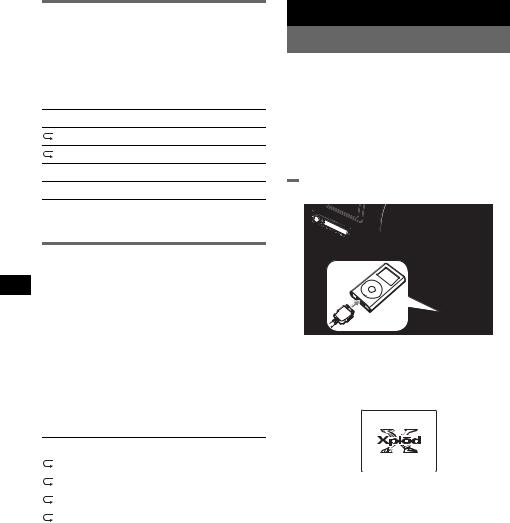
Listening to music on a Mass Storage Class type audio device
Repeat and shuffle play
1During playback, press (3) (REP) or (4) (SHUF) repeatedly until the desired setting appears.
Select |
To play |
TRACK |
track repeatedly. |
ALBUM |
album repeatedly. |
SHUF ALBUM |
album in random order. |
SHUF DEVICE |
device in random order. |
To return to normal play mode, select “ OFF” or “SHUF OFF”.
OFF” or “SHUF OFF”.
Listening to music on “Walkman” (ATRAC Audio Device)
1During playback, press (MODE) repeatedly until the desired setting appears.
The item changes as follows:
ALB (Album) t ART (Artist) t PLY (Playlist)
Repeat and shuffle play
1During playback, press (3) (REP) or (4) (SHUF) repeatedly until the desired setting appears.
Select |
To play |
TRACK |
track repeatedly. |
|
|
ALBUM |
album repeatedly. |
|
|
ARTIST |
artist repeatedly. |
|
|
PLAYLIST |
playlist repeatedly. |
|
|
SHUF ALBUM |
album in random order. |
|
|
SHUF ARTIST |
artist in random order. |
|
|
SHUF PLAYLIST |
playlist in random order. |
|
|
SHUF DEVICE |
device in random order. |
|
|
To return to normal play mode, select “ OFF” or “SHUF OFF. ”
OFF” or “SHUF OFF. ”
iPod
Playing back iPod
By connecting an iPod to the dock connector at the rear of the unit, you can listen on your car speakers, while controlling the iPod from the unit.
Notes
•When an iPod is connected to the dock connector, operation from the iPod cannot be performed.
•Before connecting the iPod to the dock connector, turn down the volume of the unit.
Playing tracks
MENU
1Connect the iPod to the dock connector.
The iPod will turn on automatically, and the display will appear on the iPod screen as below.
2Press (SOURCE) to select the PD.
“PD 1 PORTABLE” appears, and the tracks on the iPod start playing automatically from the point last played.
3Press (MODE) to select the play mode.
The mode changes as follows;
RESUMING t ALBUM t ARTIST t
PLAYLIST
4Adjust the volume.
Press (OFF) to stop playback.
Tips
•When the iPod is connected to the dock connector, the mode changes to the Resuming mode. In Resuming mode, pressing the Repeat, Shuffle or Scan button does not function. If you cancel Resuming mode by pressing (MODE) or (1)/ (2) (GP/ALBM –/+), the Repeat, Shuffle or Scan buttons
now function to change the play mode.
10
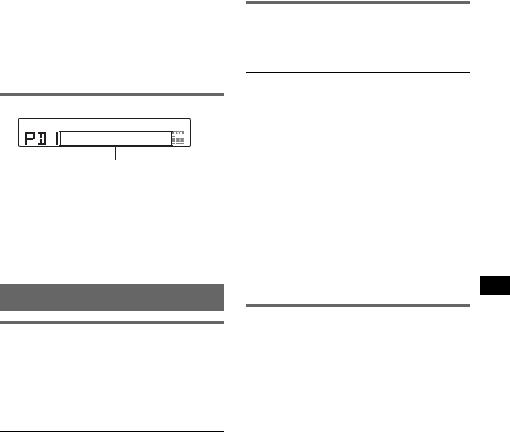
•When the ignition key is turned to the ACC position, or the unit is on, the iPod will be recharged.
•If the iPod is disconnected during playback, playback will pause.
Note
An another iPod cannot be connected using the XA110IP.
Display items
Track/album/artist name, Track number, Elapsed playing time, Clock
To change display items, press (DSPL); scroll display items, press (SCRL) or set “A.SCRLON” (page 12).
Note
Some letters stored in iPod may not be displayed correctly.
Setting the play mode
Selecting Album, Artist or Playlist
1During playback, press (MODE).
The mode changes as follows:
ALBUM t ARTIST t PLAYLIST
Skipping albums, artists and playlists
To |
Press |
Skip |
(1)/(2) (GP/ALBM –/+) |
|
[press once for each] |
|
|
Skip |
(1)/(2) (GP/ALBM –/+) |
continuously |
[hold to desired point] |
|
|
Repeat and shuffle Play
1During playback, press (3) (REP) or
(4) (SHUF) until the desired setting appears.
Select |
To play |
REP TRK |
track repeatedly. |
|
|
REP ALB |
album repeatedly. |
|
|
REP ART |
artist repeatedly. |
|
|
REP PLY |
playlist repeatedly. |
|
|
SHUF ALB |
album in random order. |
|
|
SHUF ART |
artist in random order. |
|
|
SHUF PLY |
playlist in random order. |
|
|
SHUF ALL |
all tracks in random order. |
|
|
To return to normal play mode, select “REP OFF” or “SHUF OFF.”
Note
GP/ALBM –/+ buttons will not work during shuffle play.
Scan
You can quickly locate a specific point on the iPod.
1During playback, press (5) until
“SCAN ON” appears.
The first 10 seconds of each track will be played.
To return to normal play mode, select “SCAN OFF.”
Note
This function will not work during shuffle play.
11
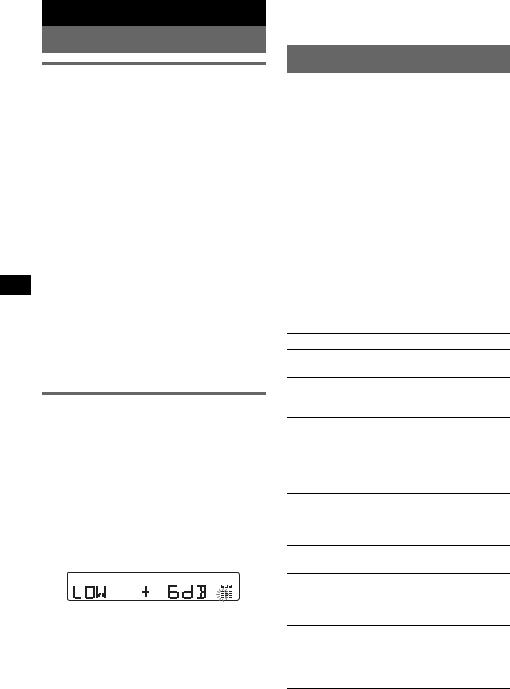
Other functions
Changing the sound settings
Adjusting the sound characteristics — BAL/FAD/SUB
You can adjust the balance, fader, and subwoofer volume.
1Press the select button repeatedly until “BAL,” “FAD” or “SUB” appears.
The item changes as follows:
LOW*1 t MID*1 t HI*1 t
BAL (left-right) t FAD (front-rear) t SUB (subwoofer volume)*2 t AUX*3
*1 When EQ3 is activated (page 12).
*2 When the audio output is set to “SUB” (page 12).
“ATT” is displayed at the lowest setting, and can be adjusted up to 20 steps.
*3 When AUX source is activated (page 13).
2Rotate the volume control dial to adjust the selected item.
After 3 seconds, the setting is complete and the display returns to normal play/reception mode.
With the card remote commander
In step 2, to adjust the selected item, press <, M, , or m.
Customizing the equalizer curve
— EQ3
“CUSTOM” of EQ3 allows you to make your own equalizer settings.
1Select a source, then press (EQ3) repeatedly to select “CUSTOM.”
2Press the select button repeatedly until “LOW,” “MID” or “HI” appears.
3Rotate the volume control dial to adjust the selected item.
The volume level is adjustable in 1 dB steps, from –10 dB to +10 dB.
Repeat steps 2 and 3 to adjust the equalizer curve.
To restore the factory-set equalizer curve, press and hold the select button before the setting is complete.
After 3 seconds, the setting is complete and the display returns to normal play/reception mode.
Tip
With the card remote commander
In step 3, to adjust the selected item, press <, M, , or m.
Adjusting setup items — SET
1Press and hold the select button.
The setup display appears.
2Press the select button repeatedly until the desired item appears.
3Rotate the volume control dial to select the setting (example “ON” or “OFF”).
4Press and hold the select button.
The setup is complete and the display returns to normal play/reception mode.
Note
Displayed items will differ, depending on the source and setting.
With the card remote commander
In step 3, to select the setting, press < or ,.
The following items can be set (follow the page reference for details):
“z” indicates the default settings.
CLOCK-ADJ (Clock Adjust) (page 5)
BEEP
To set “BEEP-ON” (z) or “BEEP-OFF.”
AUX-A*1 (AUX Audio)
To turn the AUX source display “AUX-A-ON” (z) or “AUX-A-OFF” (page 13).
A.OFF (Auto Off)
To shut off automatically after a desired time when the unit is turned off.
–“A.OFF-NO” (z), “A.OFF-30S (Seconds),” “A.OFF-30M (Minutes)” or “A.OFF-60M (Minutes).”
SUB/REAR*1
To switch the audio output.
–“SUB-OUT” (z): to output to a subwoofer.
–“REAR-OUT”: to output to a power amplifier.
DEMO*1 (Demonstration)
To set “DEMO-ON” (z) or “DEMO-OFF.”
DIM (Dimmer)
To change the brightness of the display.
–“DIM-ON”: to dim the display.
–“DIM-OFF” (z): to deactivate the dimmer.
A.SCRL (Auto Scroll)
To scroll long displayed item automatically when the disc/album/track is changed.
–“A.SCRL-ON” (z): to scroll.
–“A.SCRL-OFF”: to not scroll.
12 Other equalizer types are also adjustable.

LOCAL (Local Seek Mode)
–“LOCAL-ON” : to only tune into stations with stronger signals.
–“LOCAL-OFF” (z): to tune normal reception.
MONO*2 (Monaural Mode)
To improve poor FM reception, select monaural reception mode.
–“MONO-ON” : to hear stereo broadcast in monaural.
–“MONO-OFF” (z): to hear stereo broadcast in stereo.
LPF*3 (Low Pass Filter)
To select the subwoofer cut-off frequency: “LPF OFF” (z), “LPF125Hz” or “LPF 78Hz.”
BTM (page 8)
*1 When the unit is turned off.
*2 When FM is received.
*3 When the audio output is set to “SUB.”
Using optional equipment
Auxiliary audio equipment
By connecting an optional portable audio device to the AUX input jack (stereo mini jack) on the unit and then simply selecting the source, you can listen on your car speakers.
The volume level is adjustable for any difference between the unit and the portable audio device. Follow the procedure below:
Connecting the portable audio device
1Turn off the portable audio device.
2Turn down the volume on the unit.
3Connect to the unit.
 AUX
AUX
AUX
Connecting cord*
(not supplied)
* Be sure to use a straight type plug.
Adjust the volume level
Be sure to adjust the volume for each connected audio device before playback.
1Turn down the volume on the unit.
2Press (SOURCE) repeatedly until “AUX” appears.
“AUX FRONT IN” appears.
3Start playback of the portable audio device at a moderate volume.
4Set your usual listening volume on the unit.
5Press the select button repeatedly until “AUX” appears, and rotate the volume control dial to adjust the input level (–8 dB to +18 dB).
CD/MD changer
Selecting the changer
1Press (SOURCE) repeatedly until “CD” or “MD” appears.
2Press (MODE) repeatedly until the desired changer appears.
Unit number Disc number
Playback starts.
Skipping albums and discs
1During playback, press (1)/(2) (GP/ALBM – /+).
To skip |
Press (1)/(2) (GP/ALBM –/ |
|
+) |
||
|
||
|
|
|
album |
and release (hold for a |
|
|
moment). |
|
|
|
|
album |
within 2 seconds of first |
|
continuously |
releasing. |
|
|
|
|
discs |
repeatedly. |
|
|
|
|
discs |
then, press again within 2 |
|
continuously |
seconds and hold. |
|
|
|
|
|
continue to next page t |
13
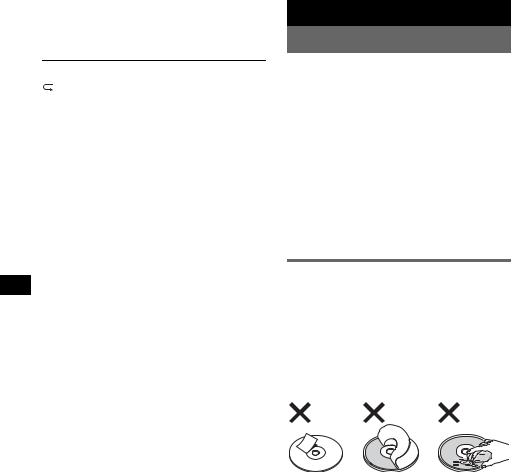
Repeat and shuffle play
1During playback, press (3) (REP) or (4) (SHUF) repeatedly until the desired setting appears.
Select |
To play |
DISC*1 |
disc repeatedly. |
SHUF |
tracks in the changer in random |
CHANGER*1 |
order. |
SHUF ALL*2 |
tracks in all units in random |
|
order. |
|
|
*1 When one or more CD/MD changers are connected.
*2 When two or more MD changers are connected.
To return to normal play mode, select “  OFF” or “SHUF OFF.”
OFF” or “SHUF OFF.”
Additional Information
Precautions
•If your car has been parked in direct sunlight, allow the unit to cool off before operating it.
•Power antenna (aerial) will extend automatically while the unit is operating.
Moisture condensation
On a rainy day or in a very damp area, moisture condensation may occur inside the lenses and display of the unit. Should this occur, the unit will not operate properly. In such a case, remove the disc and wait for about an hour until the moisture has evaporated.
To maintain high sound quality
Be careful not to splash juice or other soft drinks onto the unit or discs.
Notes on discs
•To keep a disc clean, do not touch its surface. Handle the disc by its edge.
•Keep your discs in their cases or disc magazines when not in use.
•Do not subject discs to heat/high temperature. Avoid leaving them in a parked car or on a dashboard/rear tray.
•Do not attach labels, or use discs with sticky ink/ residue. Such discs may stop spinning when used, causing a malfunction, or may ruin the disc.
•Do not use any discs with labels or stickers attached.
The following malfunctions may result from using such discs:
–Inability to eject a disc (due to a label or sticker peeling off and jamming the eject mechanism).
–Inability to read audio data correctly (e.g., playback skipping, or no playback) due to heat shrinking of a sticker or label causing a disc to warp.
•Discs with non-standard shapes (e.g., heart, square, star) cannot be played on this unit. Attempting to do so may damage the unit. Do not use such discs.
•You cannot play 8 cm (3 1/4 in) CDs.
14
